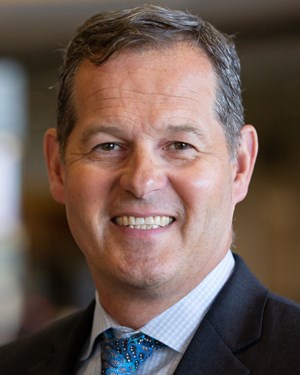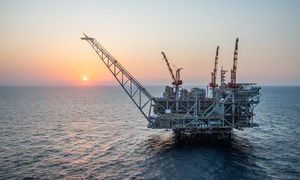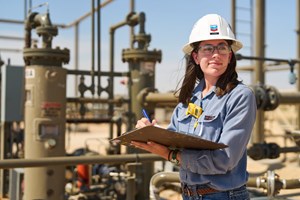The C-Suite series: Chevron’s Hearne optimistic about firm’s growth in a future of low-carbon operations
Interview with A. NIGEL HEARNE, Chevron
Welcome to World Oil’s new, recurring series of interviews with top executives in the upstream industry, or as we call it, The C-suite Series. For this first installment, we are pleased to bring you Chevron Executive Vice President A. Nigel Hearne, responsible for Oil, Products and Gas. As you will discover while reading through this interview, Chevron has ambitious plans to build the upstream system of tomorrow by focusing on high-quality assets while operating in a low-carbon manner. This will enable the company to provide the energy that the world needs while delivering higher returns and quality shareholder value.
As a 34-year veteran of the company, Mr. Hearne is well-qualified and well-positioned to help Chevron attain its goals. His comments reflect a perspective shaped by years of fulfilling positions of increasing responsibility over a wide range of functions and regions.

World Oil (WO): Nigel, how do you see the overall health of the global upstream oil and gas market at present?
Nigel Hearne (NH): The recent energy market volatility has brought to the forefront the importance of balancing economic prosperity, energy security and environmental protection. Economies need affordable energy to create prosperity, and more sources of energy are critical to keeping global supply and demand in balance. In this evolving global environment, our approach remains constant. We are dedicated to delivering the lower-carbon energy a growing world needs today, while working to build the global energy system of tomorrow. We’re focused on businesses and regions, where we can leverage our strengths, and we intend to grow both traditional and new energy businesses.
WO: Where (specific countries or U.S. states) does Chevron see some of the best upstream oil and gas opportunities?
NH: Our objective is to safely deliver higher returns, lower carbon, and superior shareholder value, in any business environment. This means we focus on investing in high-quality assets within areas where we have a competitive advantage. We’re progressing opportunities across our regions and, over the next five years, we expect unit upstream earnings to increase over 50% at flat prices.
We have a large position in the U.S. Permian basin, with a unique royalty advantage, where we learn from our own operations and from others. We are continuing to build activity levels in the region, and we expect to reach 1 MMboed in the basin by 2025. We also remain focused on completing our plans and hitting the key milestones on our Tengizchevroil (TCO) project in Kazakhstan. We expect start-up of our Wellhead Pressure Management Project (WPMP) to begin by the end of this year, and the start-up of the Future Growth Project (FGP), which adds 260,000 bpd of oil production, to begin in the middle of next year. We are a leader in applying new technologies and continue to develop high-quality resources in Australia, the Eastern Mediterranean, and in the U.S. Gulf of Mexico. These are some of the many opportunities that we are progressing.
It’s important that the industry continues to invest in energy supply and infrastructure to provide the lower-carbon energy the world needs. Chevron will maintain its capital discipline to invest and grow where we can be competitive and where there is a stable business and policy environment to do so.
WO: As opposed to previous up-and-down cycles in the upstream market, many companies seem to be pursuing stable, slow growth in activity—maybe even keeping capex flat in the next year—as opposed to quickly ramping up spending. Is it accurate to say that Chevron falls into that group, given that your firm’s corporate capex is $14 billion in 2023, and is projected at $13 billion to $15 billion annually through 2027?
NH: We aim to grow our business by improving productivity, returns, and free cash flow, and through capital discipline. Our objective remains the same, to deliver higher returns and lower carbon. Instead of being swayed by short-term fluctuations or price changes, we develop our plans, based on a view of long-term fundamentals. In a cyclical commodity business, capital and cost discipline always matter. We’re prioritizing cost management and continuing to leverage technology to enhance our performance. At the same time, we’re investing more to help grow future energy supplies. In 2023, we've increased our capital expenditures by more than 30%, compared to last year. This is in response to growing activity and rising costs.
WO: What, and where, are some of Chevron’s most important international (outside the U.S.) upstream projects?
NH: In addition to TCO in Kazakhstan, we have a strong set of upstream projects globally. In Nigeria, we’ll begin a 37-well infill program on the Nigerian shelf, while on the Angola shelf, we achieved first oil from one of our new factory-style designs. We have over 20 Tcf of net natural gas resource in West Africa, with gas offtake positions in Angola and Equatorial Guinea. Last year, in Australia, we shipped a record-breaking number of liquified natural gas (LNG) cargoes, and our Gorgon Stage 2 project began producing gas in early June.
Our assets in the Eastern Mediterranean are highly reliable. Chevron operates the Leviathan and Tamar offshore natural gas fields located offshore Israel, Fig. 1. These assets supply around 70% of Israel’s electricity. The Tamar project is producing about 1.1 Bcfd, and Leviathan is producing about 1.2 Bcfd. Natural gas production in the region is helping to reduce Israel’s greenhouse gas emissions and improve air quality. We are also continuing to develop our resource base in this region with an exploration program in Egypt with six offshore blocks, and an appraisal program at the Aphrodite gas field, offshore Cyprus.

WO: What, and where, are some of Chevron’s most important upstream projects inside the U.S.?
NH: We are growing U.S. energy production and lowering the carbon intensity of our operations, which are among the most efficient, responsibly produced in the world. In the U.S., our operations span the Gulf of Mexico and the Permian basin in Texas and New Mexico. As a result, we're one of the leading leaseholders and producers in these basins.
This past May, we announced that we entered into a definitive agreement with PDC Energy, Inc. to acquire all of the outstanding shares of PDC. The acquisition of PDC provides us with high-quality assets adjacent to our existing position in the Denver-Julesburg (DJ) basin. The acquisition is subject to PDC shareholder approval and other customary closing conditions
In our Gulf of Mexico operations, we expect production to grow to 300,000 bopd by 2026, and I’m proud to note that thanks to the work of our dedicated teams, the Anchor floating production unit has been successfully moored in place at its location. First oil from Anchor, along with our non-operated Whale project, is expected next year. Ballymore and other brownfield projects that leverage our existing Gulf of Mexico infrastructure are also on track.
We are also continuing to reduce upstream greenhouse gas intensity, which is down 30% from 2016. Our U.S. Gulf of Mexico facilities are some of the lowest carbon intensity producing assets in the world, and our Permian operations have among the lowest methane emissions per site of any operator, Fig. 2.

WO: What are some of the most important upstream technologies/innovations that Chevron is utilizing in exploration, drilling, completions or production?
NH: To me, there has never been a better time to be in the energy industry, particularly when it comes to leveraging technology. At Chevron, we’re focused on technology that delivers energy solutions for today and transforms the energy system of the future.
The technologies we deploy help us cost-effectively find and commercialize new oil and gas fields, recover more resources from existing fields, and lower carbon emissions. They also enable us to integrate data and information, so that we can manage and develop our global assets efficiently and effectively.
For example, in our shale and tight assets, we’re utilizing subsurface technologies and advanced materials designed to increase reservoir recoveries. We have developed a new technology to get higher-quality seismic images faster to optimize field developments, and we’ve used this technology in the Gulf of Mexico and in other challenging geological environments. To help manage methane emissions, we’re leveraging machine learning to predict and prevent emissions, and we've tested advanced technologies, including satellites, to detect and make timely repairs.
Technology plays an important role in helping us deliver affordable, reliable, ever-cleaner energy that fuels human progress and economic growth around the world.
WO: In recent presentations, your firm has expressed a desire to “safely deliver higher returns, but with lower carbon.” More specifically, this is expressed as maintaining capital and cost discipline while growing traditional energy and giving superior distributions to shareholders. At the same time, there is a goal to progress toward carbon targets, become a leader in methane management and grow renewable fuels. What is the strategy to accomplish all of this?
NH: At Chevron, we believe the future of energy is lower-carbon, and we intend to lead in that future. We’ve been consistent on our strategy, which is to leverage our strengths to supply lower-carbon energy to a growing world. As I mentioned earlier, we are being cost- and capital-disciplined and continuing to leverage technology to enhance our performance and grow our business.
In 2021, we established planned capital spend of approximately $10 billion through 2028 to advance our lower-carbon strategy. This includes approximately $2 billion to lower the carbon intensity of our traditional oil and gas operations, and approximately $8 billion for lower-carbon investments in renewable fuels, hydrogen and carbon capture and offsets.
Chevron aspires to reach net zero upstream emissions (Scope 1 and 2) by 2050. Accomplishing this aspiration depends on continuing progress on commercially viable technology, government policy, successful negotiations for carbon capture and storage and nature-based projects, availability of cost-effective, verifiable offsets, and granting of necessary permits by governing authorities.
WO: The offshore E&P sector seems to be recovering well from the Covid-caused downturn of 2020-2022. Is that your sense of things, and will Chevron continue focusing on deepwater projects in the U.S. Gulf of Mexico, West Africa, Australia and the eastern Mediterranean?
NH: Our global deepwater natural gas projects are a key component of our portfolio. We have over 175 Tcf of net natural gas resource, and we’re building flexibility into how we connect our growing natural gas production with customers. In Africa, last year, we acquired working interest in Namibia’s offshore Orange basin, strengthening our upstream exploration portfolio and our presence in the continent’s energy sector.
Specific to LNG, we have a large LNG position in Australia. We also have LNG positions in Angola and Equatorial Guinea, primarily serving our customers in Europe. As I mentioned earlier, we have a large gas resource position in the Eastern Mediterranean, in Israel, that’s currently producing, and exploration programs in Egypt and Cyprus. All these fit well with Chevron's strong commercialization capabilities, and it's a very important resource for the future of the region.
In the latter part of this decade, we have plans to expand our LNG portfolio. We are currently working on developing options to supply LNG to Europe and Asia, leveraging agreements we signed last year. This supply will come from the U.S. Gulf Coast and potentially from our Eastern Mediterranean assets.
WO: Speaking of Australia, how is your firm’s CCS project at Gorgon progressing?
NH: Chevron’s Gorgon CCS system in Australia is one of the most complex CCS projects in the world. We've stored more than 8 million tonnes of CO2 since start-up in 2019, but it's below the planned capacity. We're working hard to reach that goal, with the CO2 injection process on track; however, our main constraint currently is managing the water effectively. We have to take water out of the reservoir, located beneath Barrow Island, to create space for the CO2, and we’ve had some constraints because the water that we’re removing has particulates, and it has to be processed. The solution being progressed is to increase the surface equipment capacity to remove the particulates, process and inject more water, and store more CO2.
It’s important to note that we will leverage these learnings from Gorgon, as we look to subsequent CCS developments. We believe CCS is critical to a lower-carbon future and essential to achieving the net zero goals of the Paris Agreement.
WO: What is the pace of Chevron’s work on renewable energy, and is there a specific focus on one of these forms, such as wind power, particularly offshore wind?
NH: We are growing our traditional oil and gas business while lowering the carbon intensity of our operations, as well as growing new, lower-carbon businesses in areas where we have strengths, like renewable fuels, hydrogen, carbon capture, offsets, and other emerging technologies. Not a lot of people know that we’re a large producer of hydrogen, producing around 1 million tonnes per year through our traditional business, and we have experience in retail hydrogen going back to 2005.
As far as wind and solar power, we are not planning large-scale investments in these industries. We plan to utilize wind and solar power for our operations.
WO: You’ve had a 34-year career, with a wide range of positions of increasing responsibility, starting with legacy Texaco and continuing many years now with Chevron. You’ve been in your current position for a little over six months—do you feel settled in now? What have been some favorite aspects of the various positions you’ve fulfilled over the years?
NH: That’s a great question. If I reflect on my three decades with this wonderful company, across roles and across different geographies, what stands out to me is a sense of gratitude for the remarkable individuals that I’ve had the opportunity to work with. Throughout the years, I have witnessed first-hand the power of human ingenuity to solve complex challenges, and this fills me with optimism. My colleagues have taught me invaluable lessons about resilience and about the great potential that lies within each of us. I truly believe that we have some of the smartest professionals at Chevron and in our industry, and it’s this collective brilliance and dedication that will allow us to turn challenges into opportunities and continue to enable human progress.
WO: Any final thoughts that you would like to mention?
NH: There is probably no industry more critical, or more crucial to our lives, than energy. At Chevron, our employees are proud to help develop the energy that improves lives and powers the world forward. We live this purpose every day, and we intend to lead in the future of energy.
- The last barrel (February 2024)
- Oil and gas in the Capitals (February 2024)
- What's new in production (February 2024)
- First oil (February 2024)
- E&P outside the U.S. maintains a disciplined pace (February 2024)
- Prices and governmental policies combine to stymie Canadian upstream growth (February 2024)
- Applying ultra-deep LWD resistivity technology successfully in a SAGD operation (May 2019)
- Adoption of wireless intelligent completions advances (May 2019)
- Majors double down as takeaway crunch eases (April 2019)
- What’s new in well logging and formation evaluation (April 2019)
- Qualification of a 20,000-psi subsea BOP: A collaborative approach (February 2019)
- ConocoPhillips’ Greg Leveille sees rapid trajectory of technical advancement continuing (February 2019)


